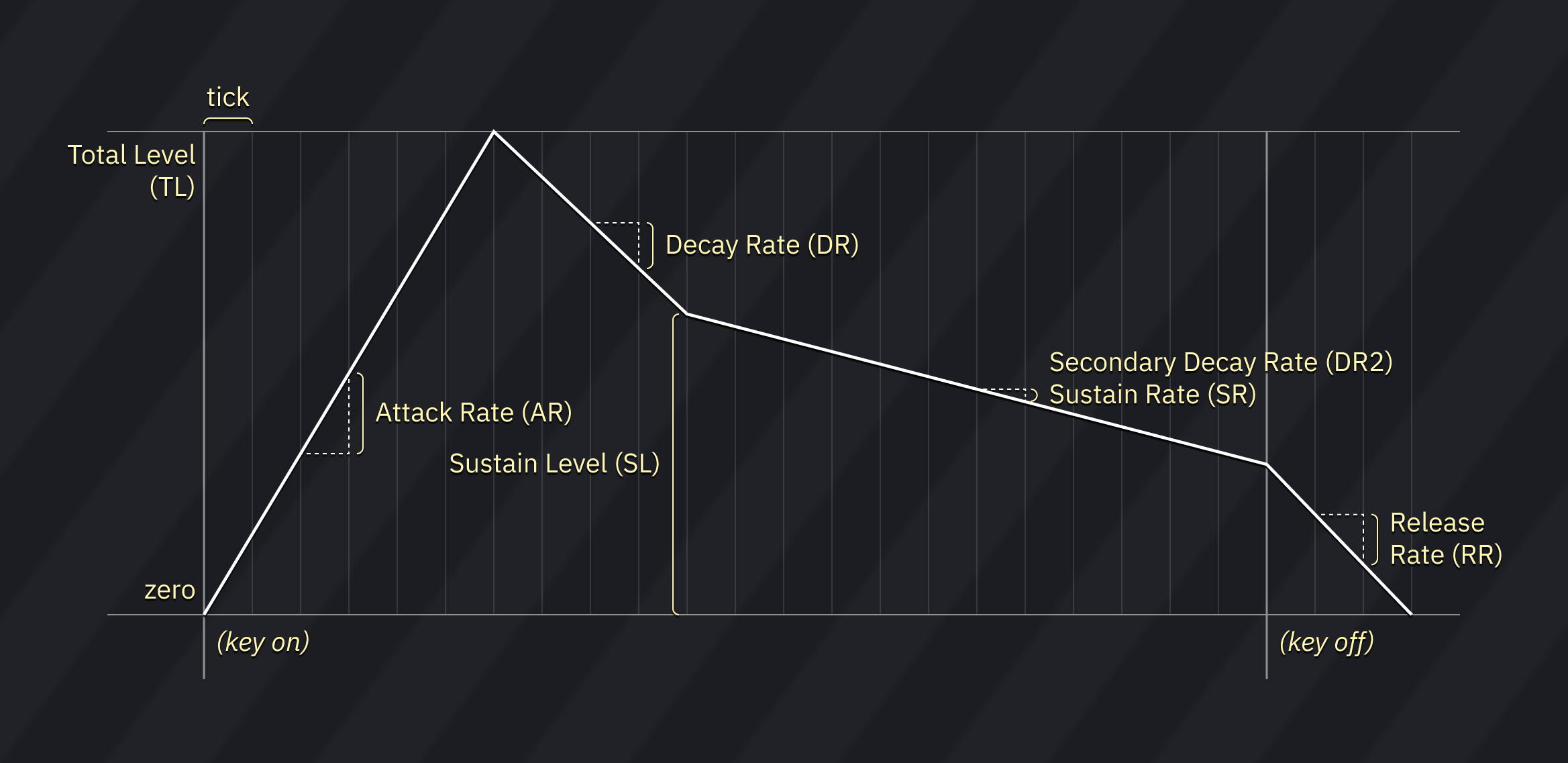4 KiB
OPLL FM synthesis instrument editor
The OPLL FM editor is divided into 5 tabs:
- FM: for controlling the basic parameters of FM sound source.
- Macros (FM): for macros controlling algorithm, waveform and feedback.
- Macros (OP1): for macros controlling FM parameters of operator 1.
- Macros (OP2): for macros controlling FM parameters of operator 2.
- Macros: for miscellaneous macros controlling volume, arpeggio, and preset.
FM
the OPLL synthesizer is two-operator, meaning it takes two oscillators to produce a single sound. however, unlike the other FM chips, only one custom patch may be set at a time, shared among all 9 channels.
but don't worry! there also are 15 preset patches that you may select at any time.
these apply to the instrument as a whole:
- Feedback (FB): Determines how many times operator 1 returns its output to itself (0 to 7).
- Sustain (SUS): enables the sustain flag (sets the release rate to 5).
- DC (half-sine carrier): Sets the waveform produced by carrier operator to half-sine.
- DM (half-sine modulator): Sets the waveform produced by modulator operator to half-sine.
- preset dropdown: selects OPLL preset instrument.
- this is the selector for the preset patches I mentioned before.
- once a preset patch is selected, only the volume is configurable.
- only one user-specified patch may be applied at a time!
if you select the special Drums patch, you may use the instrument in Drums mode of OPLL. an extra setting also appears:
- Fixed frequency mode: allows you to set a fixed frequency for the drum channels.
These apply to each operator:
- The crossed-arrows button can be dragged to rearrange operators.
- Amplitude Modulation (AM): Makes the operator affected by LFO tremolo.
- Envelope generator sustain flag (EGS): When enabled, value of Sustain Level is in effect.
- Attack Rate (AR): determines the rising time for the sound. The bigger the value, the faster the attack (0 to 15).
- Decay Rate (DR): Determines the diminishing time for the sound. The higher the value, the shorter the decay. It's the initial amplitude decay rate (0 to 15).
- Sustain Level (SL): Determines the point at which the sound ceases to decay and changes to a sound having a constant level. The sustain level is expressed as a fraction of the maximum level (0 to 15).
- Release Rate (RR): Determines the rate at which the sound disappears after KEY-OFF. The higher the value, the shorter the release (0 to 15).
- Total Level (TL): Represents the envelope’s highest amplitude, with 0 being the largest and 63 (decimal) the smallest. A change of one unit is about 0.75 dB.
- in the case of the second operator, it goes from 0 to 15 instead.
- Key Scale Level (KSL): Also known as "Level Scale". Determines the degree to which the amplitude decreases according to the pitch.
- Envelope Scale (KSR): Also known as "Key Scale". Determines the degree to which the envelope execution speed increases according to the pitch.
- Frequency Multiplier (MULT): Determines the operator frequency in relation to the pitch. (0-10, 12, 15 range)
- Vibrato (VIB): Makes the operator affected by LFO vibrato.
macros
Macros define the sequence of values passed to the given parameter. Via macro, along with the previously mentioned parameters, the following can be controlled:
FM Macros
All parameters are listed above.
OP1-OP4 Macros
All parameters are listed above.
Macros
- Arpeggio: pitch change sequence.
- Patch: changes the playing preset mid-note.
- through use of this macro, you may unlock different glitched sounds. useful for distortion guitars!
- Pitch: fine pitch.
- Relative: when enabled, pitch changes are relative to the current pitch.
- Phase Reset: restarts all operators and resets the waveform to its start.
links
FM instrument tutorial: A great starting point to learn how create and work with FM sounds. This was made for DefleMask, but all the same principles apply.
